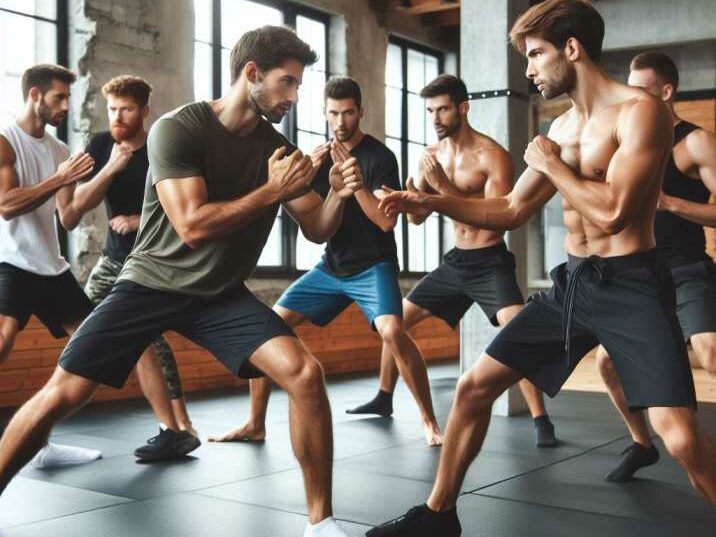Introduction:
Table of Contents
Embarking on a journey to find the best defensive martial art is not merely about choosing a fighting style; it’s about understanding the nuances of various techniques, philosophies, and training methods. In this comprehensive guide, we will unravel the secrets behind each heading and subheading, providing you with the knowledge and insights necessary to make an informed decision.

Table of Contents:
- Introduction
- Understanding the Concept of Defensive Martial Art
- Historical Origins and Evolution
- Ancient Traditions
- Modern Innovations
- Practical Applications in Real-Life Situations
- Street Attacks
- Home Invasions
- Techniques and Training Methods
- Striking Techniques
- Grappling Techniques
- Training Drills and Sparring
- Mental and Emotional Preparedness
- Meditation and Mindfulness
- Psychological Training
- Choosing the Right Martial Art for You
- Personal Preferences
- Physical Fitness Level
- Specific Self-Defense Goals
- Conclusion
Understanding the Concept of Defensive Martial Art:
Defense is the cornerstone of any martial art, encompassing a range of strategies and techniques aimed at protecting oneself from physical harm. This heading explores the fundamental principles of defense, including blocking, evading, and controlling distance, laying the groundwork for effective self-protection.
Blocking:
Blocking involves using limbs or other body parts to intercept and deflect incoming attacks. Techniques may vary depending on the martial art, with some styles emphasizing hard blocks to stop strikes forcefully, while others focus on soft blocks to redirect the energy of the attack.
Evading:
Evading techniques are designed to avoid incoming attacks altogether, utilizing footwork, body movement, and timing to sidestep or duck under strikes. By mastering evasive maneuvers, practitioners can minimize the risk of being hit and create openings for counterattacks.
Controlling Distance:
Controlling distance is essential for managing the dynamics of a fight, allowing practitioners to maintain a safe distance from their opponent or close in for an attack. Strategies for controlling distance may include footwork patterns, feints, and establishing a dominant position in the fight.
Historical Origins and Evolution:
The rich history of martial arts is a tapestry woven with cultural traditions, philosophical insights, and practical innovations. This heading explores the diverse origins and evolutionary paths of different martial arts, shedding light on how they have adapted and flourished over time.
Ancient Traditions:
Many martial arts trace their roots back to ancient civilizations, where combat techniques were developed for self-defense, warfare, and personal growth. Ancient traditions such as kung fu in China, karate in Okinawa, and taekwondo in Korea continue to influence modern martial arts practices.
Modern Innovations:
In the modern era, martial arts have evolved to meet the needs and challenges of contemporary society. Styles like Krav Maga, developed by the Israeli military, prioritize practicality and efficiency in self-defense, drawing on a combination of striking, grappling, and defensive tactics.
Practical Applications in Real-Life Situations:
While martial arts are often associated with stylized forms and rituals, their true value lies in their practical applications for self-defense. This heading examines how different martial arts fare in real-life scenarios, from street attacks to home invasions, offering insights into their effectiveness in protecting oneself and others.
Street Attacks:
Street attacks are unpredictable and chaotic, requiring quick thinking and decisive action. Martial arts that emphasize simplicity, adaptability, and situational awareness, such as Krav Maga and Brazilian Jiu-Jitsu, are well-suited for defending against street attacks.
Home Invasions:
Home invasions present unique challenges, as practitioners must defend themselves and their loved ones in confined spaces. Martial arts that focus on close-quarters combat and improvised weapons, such as Filipino Martial Arts (FMA) and Jeet Kune Do, can be effective in these situations.
Techniques and Training Methods:
At the heart of any martial art are its techniques and training methods, which shape the way practitioners approach combat and self-defense. This heading delves into the diverse range of techniques and training methods employed by different martial arts, providing a deeper understanding of their effectiveness and applicability.
Striking Techniques:
Striking techniques, including punches, kicks, elbows, and knees, form the backbone of many martial arts systems. Styles like Muay Thai and Boxing excel in teaching powerful and precise striking techniques, honed through rigorous training drills and pad work.
Grappling Techniques:
Grappling techniques, such as throws, joint locks, and chokes, focus on controlling an opponent through close contact and leverage. Martial arts like Brazilian Jiu-Jitsu and Judo specialize in grappling techniques, teaching practitioners how to manipulate an opponent’s body position and submit them with minimal effort.
Training Drills and Sparring:
Training drills and sparring sessions are essential for developing practical skills and testing them against resisting opponents. Whether practicing kata in a traditional dojo or engaging in full-contact sparring in a combat sports gym, consistent training is key to mastering any martial art.
Mental and Emotional Preparedness:
Self-defense is not just about physical techniques; it also requires mental and emotional fortitude to stay calm and focused in high-stress situations. This heading explores how different martial arts cultivate mental resilience and emotional intelligence, equipping practitioners with the confidence and clarity needed to navigate dangerous encounters.
Meditation and Mindfulness:
Many martial arts incorporate meditation and mindfulness practices to cultivate inner peace and concentration. Techniques such as breathing exercises, visualization, and Zen meditation help practitioners develop a calm and centered mindset, essential for effective self-defense.
Psychological Training:
Psychological training in martial arts focuses on understanding the psychology of violence and learning how to manage fear, stress, and aggression. By role-playing different scenarios and practicing assertive communication, practitioners can develop the mental skills needed to de-escalate conflicts and protect themselves assertively.
Choosing the Right Martial Art for You:
With countless martial arts styles to choose from, finding the right one can feel overwhelming. This heading offers practical advice and considerations for selecting a martial art that aligns with your goals, interests, and physical capabilities.
Personal Preferences:
Consider your personal preferences when choosing a martial art, including your preferred learning environment, teaching style, and cultural influences. Whether you’re drawn to the discipline of traditional karate or the intensity of mixed martial arts (MMA), find a style that resonates with you on a personal level.
Physical Fitness Level:
Assess your physical fitness level honestly and choose a martial art that matches your current abilities and goals. While some styles may require high levels of strength and flexibility, others focus on leverage, timing, and technique, making them accessible to practitioners of all fitness levels.
Specific Self-Defense Goals:
Identify your specific self-defense goals, whether it’s gaining confidence, improving fitness, or learning practical skills for personal safety. Different martial arts offer unique benefits and approaches to self-defense, so choose a style that aligns with your objectives and priorities.

Additional Insights:
Cultural Significance:
Explore how different martial arts styles are deeply intertwined with the cultures from which they originated. Discuss how cultural values, traditions, and beliefs influence the philosophy and practice of each martial art.
Health and Fitness Benefits:
Highlight the physical fitness benefits of practicing martial arts, such as improved strength, flexibility, coordination, and cardiovascular health. Discuss how regular training can enhance overall well-being and contribute to a healthy lifestyle.
Role of Instructors and Training Facilities:
Emphasize the importance of skilled instructors and quality training facilities in learning martial arts effectively. Provide tips for choosing a reputable dojo or gym and finding instructors who prioritize safety, respect, and proper technique.
Community and Camaraderie:
Discuss the sense of community and camaraderie fostered within martial arts schools and training groups. Highlight the social benefits of connecting with like-minded individuals, building friendships, and supporting one another on the martial arts journey.
Competition and Sport:
Explore the role of martial arts in competitive sports, such as MMA, boxing, judo, and taekwondo. Discuss the benefits of competition for skill development, character building, and showcasing martial arts on a global stage.
Cross-Training and Hybrid Styles:
Introduce the concept of cross-training, where practitioners explore multiple martial arts styles to gain a well-rounded skill set. Discuss the emergence of hybrid martial arts styles that blend elements from different traditions, offering practitioners greater versatility and adaptability.
Historical Figures and Legends:
Share stories of legendary martial artists and historical figures who have shaped the evolution of martial arts. Discuss their contributions to the development of techniques, philosophies, and training methods, inspiring future generations of practitioners.
Conclusion:
In conclusion, finding the best defensive martial art is a journey of self-discovery and exploration. By understanding the significance of different headings and subheadings, along with their associated insights and considerations, you can make an informed decision that empowers you to protect yourself and others effectively. Whether you choose a traditional discipline steeped in history or a modern system tailored for practicality, the key is to find a martial art that resonates with your goals, values, and aspirations.
Frequently Asked Questions (FAQs):
- Q: What is the best martial art for self-defense?
- A: The best martial art for self-defense depends on various factors such as personal preference, physical fitness, and specific goals. Some popular options include Krav Maga, Brazilian Jiu-Jitsu, and Muay Thai.
- Q: Can anyone learn self-defense?
- A: Yes, anyone can learn self-defense with the right training and practice. Martial arts schools and self-defense classes cater to people of all ages, genders, and fitness levels.
- Q: How long does it take to become proficient in self-defense?
- A: The time it takes to become proficient in self-defense varies depending on individual aptitude, dedication to training, and the complexity of the martial art. Generally, it can take several months to several years to develop solid skills.
- Q: Is self-defense training only for physical protection?
- A: No, self-defense training encompasses not only physical protection but also mental and emotional preparedness. It teaches individuals how to recognize and avoid dangerous situations, assertively communicate boundaries, and stay calm under pressure.
- Q: What role does mindset play in self-defense?
- A: Mindset plays a crucial role in self-defense as it affects how individuals perceive and respond to threats. A confident and assertive mindset can deter potential attackers and empower individuals to take decisive action in dangerous situations.


